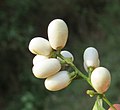Toxicity
Ingestion of C. nocturnum has not been well documented, but there is some reason to believe that caution is in order. All members of the family Solanaceae contain an alkaloid toxin called solanine, [10] though some members of the family are routinely eaten without ill-effect. The most commonly reported problems associated with C. nocturnum are respiratory problems from the scent, and feverish symptoms following ingestion. [11]
Some people, especially those with respiratory sensitivities or asthma, have reported difficulty breathing, irritation of the nose and throat, headache, nausea, or other symptoms when exposed to the blossom's powerful scent. [12] Some Cestrum species contain chlorogenic acid, and the presence of this potent sensitizer may be responsible for this effect in C. nocturnum.
Some plant guides describe C. nocturnum as "toxic" and warn that ingesting plant parts, especially fruit, may result in elevated temperature, rapid pulse, excess salivation and gastritis. [13]
Spoerke and Smolinske (1990) [14] noted the following: "Ingesting 15 lb of plant material caused a cow to salivate, clamp its jaws, collapse, and eventually die. A postmortem showed gastroenteritis and congestion of liver, kidneys, brain, and spinal cord. Although the berries and the sap are suspected of being toxic, [15] several cases of ingestion of the berries have not shown them to be a problem, with one exception. Morton [16] cites two cases where children ate significant quantities (handfuls) of berries and had no significant effects and another two where berries were ingested in smaller amounts, with similar negative results", and in a new paragraph noted that "Ingestion of green berries over several weeks by a 2-year-old child resulted in diarrhea, vomiting, and blood clots in the stool. Anemia and purpura [discoloration of the skin caused by subcutaneous bleeding] were also noted. A solanine alkaloid isolated from the stool was hemolytic to human erythrocytes." [17]
Plant extracts have shown larvicidal activity against the mosquito Aedes aegypti while showing no toxicity to fish. [18] [19] Plant extracts cause hematological changes in the freshwater fish when exposed to sub lethal concentrations. [20] [21]









